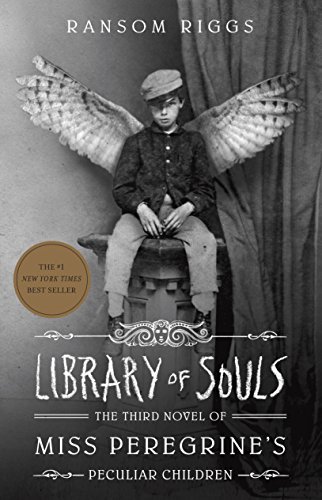- The Good: Peculiar children, magical portals, and monsters in the shadows!
- The Bad: Inconsistent characters and plot
- The Literary: A big house with doorways to different peculiar loops; museum of peculiar artifacts; a library of souls
Sixteen-year-old Jacob is on a quest to find his stolen friends. He only met them a few weeks ago when he discovered the world of peculiardom, a school where his grandfather grew up and fell in love, and a place where he might belong. An army of deadly monsters has abducted all the peculiar headmistresses and his mates, and it’s up to Jacob and his new powers to save them.
Library of Souls is the conclusion to the trilogy that begins with Miss Peregrine’s Home for Peculiar Children, a fantasy story augmented by weird vintage photographs. The photos are really what sets this series apart, and they lend a kind of authenticity, despite most of them being heavily edited. If you like old photographs and YA fantasy, this is a really unique series that uses the pairing to its advantage.
I like that the story over the three books takes place only over the course of a few short weeks and that each one picks up the moment where the last left off. The second installment follows the full menagerie of children as they race to save their headmistress through the English countryside and London during WWII. As this book opens, only Jacob, his girlfriend Emma Bloom, who can make fire with her hands, and Addison MacHenry, a talking dog who can smell and track peculiar children, are left. Compared with the wide cast of characters in the first two books, I really enjoy the quiet and more introspective journey with the core protagonists.
One of my favorite new characters is a sly ferryman named Sharon, who transports them from modern day London to the alleys of Devil’s Acre, a Victorian England slum in a secret peculiar loop. The second act is surprisingly quiet and plot heavy, with reveal after reveal of how the big bad went mad with power, how the monsters were created, and how Jacob is connected to it all. Then the third act and climax is back to the big action, fight sequences, and the will-they-or-won’t-they save-the-world-or-die-trying quest.
Unfortunately, with all the grandiosity of this climax to the finale, I find that the story becomes too wrapped up in its own plot, and it ultimately loses the magic of the first two. The characters never develop beyond reluctant protagonist, optimistic and emotionally-supportive love interest, wise headmistress, and mad ol’ power-hungry antagonist. The stakes never quite feel real, maybe partly because the only friend to have been lost in the whole series, who fell off a mountain, probably wasn’t dead according to Addison. Jacob fills the tired archetype of the chosen-one, and his role and powers are more useful than anyone else’s.
Recommended for fans of middle-grade and YA fantasy, kids with powers, and adventures through history!
